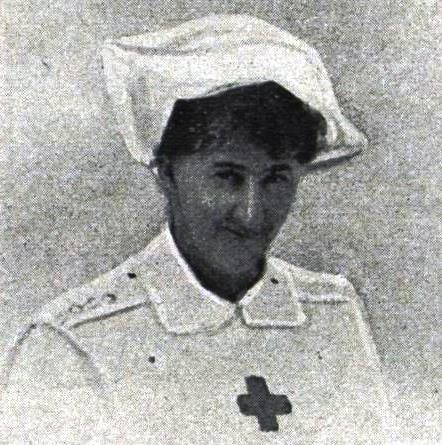
Back Row: Misses Eades, Funnell, Ross, Harvey, Sherlock, A.Readett. Second Row: Misses Holt, R.Brown, M.Summons, Paterson, Artlett. Third Row: Misses Rossiter, Luckey, F.Fyall, Burns, Earp, Coogan, Thompson, J.Brown, A.Summons, Kaylock. Front Row: Misses Crase, Lumley, R.Fyall, D.Little, L.Readett, Napper, Thorpe
The Voluntary Aid Detachment (VAD) was a volunteer organisation created in 1909 by the British Red Cross and Order of St. John. They were very prominent during the two World Wars, and were common throughout the British Empire, including Australia.
VADs were established in Australia at the beginning of World War 1 when Lady Helen Munro Ferguson initiated a nation-wide appeal to the women of Australia. She was responsible for the establishment of the Red Cross in Australia and they closely followed the policies of the British War Office and the British Red Cross.
The Parramatta VAD were formed in 1915 and were the second unit to be formed in New South Wales. The women helped with cooking, sewing and mending for the invalid soldiers. They also helped with raising money and with various patriotic movements. To be eligible to join the VAD, you had to be invited by a serving member. The first head of the Parramatta VAD was Mr John Drummond, who was an enthusiastic first aid worker.
The Parramatta VAD members included the following members – “Misses Waugh, A., L., and M Readett, R and F Fyall, Carrick, Jackson (2), L.Harvey, Curtis, Coogan, Napper, Luckey, Sherlock, Coutts, F and O, Noller, Crase, A and M.Summons, Lumley, Kaylock, Rossiter, Hill, Thompson, Artlett, Blumer, Porter, Shorter, Paterson, Ross, Funnell, Burns, Thorpe, Alexander, Cavanough, Drummond, Pearce, K and E.Betts, Cotterell, F. Harvey, Eades, Holt, Richardson, P and A Hume, Gregory, Hosford, Creagh, Morgan, Bruntnell, Hunt, Hines, Crouch, Hopkins, Colls, Husband, R, and J Brown, Earp, Copeland, D.Little.” 1

Miss DaSilva Waugh, Commandant VAD.
Source: Parramatta District Soldiers in the Great War, 1914-1919.
At the beginning of World War 1, the Australian Defence Council restricted Australian VADs from travelling overseas. However, many travelled independently and joined the British detachments, commonly working in Australian hospitals. In 1916 the policy changed and the first detachment of thirty Australian VADs left Australia in September 1916. 2
In addition to working at the front, VADs also worked on hospital ships and blood banks. They received first aid and home nursing training from St.John Ambulance Association. They worked in Red Cross convalescent homes, assisted in canteens and worked on the trains carrying the troops. They also worked in military hospitals as ward or pantry maids. Their primary duties involved unskilled work such as cleaning floors and bathrooms, bedpans, and washing patients. On the home front they also provided domestic assistance and other support for returned and wounded soldiers and their families, including the organisation of social functions.
“During the five years of war much was done, especially as the wounded and invalided soldiers were repatriated. Anticipatory to the return of our brave boys, maimed and shattered in nerve, convalescent homes had been established, and at these homes the members of the VAD found plenty of hard work awaiting them….in addition to the work at the homes and hospitals, the detachment took its turn in attending-whether the weather was wet or dry-at the buffet and the Sydney railway station and wharves to meet the trains and transports to the returned boys of this and other States.” 3
One of the the first duties of the VAD detachment was to assist the Red Cross volunteers at the field hospital they were managing in Liverpool. They helped the soldiers by sewing and mending their clothes. They also ran a regular stall selling a variety of goods to raise money for the Red Cross War effort.
After World War One, the VAD continued their work and during World War Two they played a large, similar role to what they had in the previous war. In 1967, the VAD were renamed as the Voluntary Aid Service Corps (VASC), which they are still called today. To become a member you must hold a current Senior First Aid Certificate. They provide first aid assistance at major cultural and sporting events.

Parramatta VAD entertaining QLD Returned Soldiers.
Source: Parramatta District Soldiers in the Great War, 1914-1919.

VAD Peace Day celebrations in Sydney – Parramatta VAD is the second detachment.
Source: Parramatta District Soldiers in the Great War, 1914-1919.
Footnotes:
1. Parramatta District Soldiers in the Great War 1914-1919, page 259 (Cumberland Argus Records)
2. Australian War Memorial, 9 Sept 2013. http://www.awm.gov.au/encyclopedia/vad/
3. Parramatta District Soldiers in the Great War, 1914-1919, page 259
References:
Australian Women Archives Project, The Australian Women’s Register http://www.womenaustralia.info/biogs/AWE0491b.htm
Australian Women’s Register http://trove.nla.gov.au/people/752066?c=people
Australian War Memorial http://www.awm.gov.au/encyclopedia/vad/ 9 Sept 2013)
Parramatta District Soldiers in the Great War, 1914-19, Compiled from the records of ‘The Cumberland Argus’ 1920
![]() Alison Lykissas, Cultural Collections Officer, Parramatta City Council, Heritage Visitor Centre, 2015
Alison Lykissas, Cultural Collections Officer, Parramatta City Council, Heritage Visitor Centre, 2015



